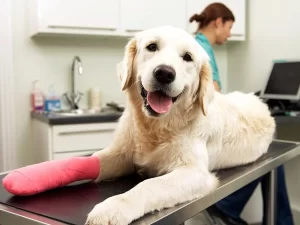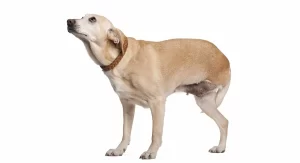At Sterling Shelter Clinic, we know that choosing to pursue an amputation is a difficult decision for you and your pet. There are many factors for you to consider before deciding to amputate, but we feel that cost should not be one of them. That’s why Sterling Shelter Clinic offers low-cost amputations for cats, dogs, and other pets, to make surgery an affordable option no matter what your budget. Our compassionate veterinary team will help you decide whether the amputation of a toe or a limb is the best treatment option for you and your pet.
Request a quote form – Please note: We are located in Central Massachusetts.
Digit (Toe) Amputations
Toe amputations are a common procedure in dogs and they are occasionally performed in other species as well. Your veterinarian may recommend a toe amputation for your pet if trauma, severe infection, a tumor, or a conformational abnormality has affected the toe to the point that it cannot heal on its own. In these cases, amputation can stop the spread of the disease, reduce pain, and improve the quality of life for your pet.
During the toe amputation surgery, your pet will be under general anesthesia and will receive medication for pain. The veterinarian will remove the diseased toe and the surrounding skin will be sutured closed to cover the defect. The veterinarian may also bandage the foot to keep the surgery site clean and protected. If the toe was removed due to a tumor or other abnormality, your veterinarian may recommend submitting it to a laboratory for further testing.
Most pets can go home within a few hours of toe amputation surgery. Your veterinarian will send your pet home with pain medications and possibly antibiotics. If a bandage was applied, your pet may need to return to the clinic in a few days for a recheck and bandage change. It is especially important for you to keep the bandage clean and dry to prevent infection. If your pet is going outside, covering the bandage with a bag or plastic wrap can help protect it from water and dirt.
It is normal for your pet to limp on the affected foot for a few days after the procedure as the area heals. If a weight-bearing toe was removed, the limping may last longer. You will need to monitor your pet for any signs of pain or infection as the area heals. If you identify any concerning changes, contact your veterinarian right away.
Request a quote form – Please note: We are located in Central Massachusetts.
Limb Amputations
Thinking about your pet losing a limb can be scary. At Sterling Shelter Clinic, we offer low-cost limb amputations so that affording the surgery will be the least of your concerns. Veterinarians often recommend limb amputation when a limb is too damaged or diseased to treat conservatively. Amputation may be the recommended treatment in cases of cancer or following a severe injury, such as a broken leg or a dislocated hip or shoulder. In many cases, amputation can be more cost-effective and more comfortable for your pet than trying to save the limb.
When amputations are performed on pets, the veterinarian typically removes the whole limb. This ensures that the pet is not hindered by a remaining stump. When a front limb is amputated, it is usually removed at the shoulder. Hind limbs are usually removed at the hip. Sometimes a hind limb is removed using a “high femur” amputation, in which a short, well-padded stump is left at about the level of the mid-thigh. Your veterinarian will choose the best amputation technique for your pet based on the location of the illness or injury.
Your pet will be placed under general anesthesia for the procedure, and pain medication will be used during and after the surgery. The veterinarian will remove the affected limb, and then the skin will be closed over the defect. Your pet will likely have external sutures or staples that will need to be removed by your veterinarian 1-3 weeks after the surgery.
For the first few days after surgery, it is important to keep your pet very quiet. Your pet should only go outside for short, slow leash walks as needed to relieve himself. You may need to use a sling to walk your pet at first while he adjusts to the missing limb. After your pet has recovered from surgery and your veterinarian has cleared him for exercise, you can start to gradually build up the length of your walks and encourage him to stand on his own.
Aftercare Following an Amputation
Most pets can go home the same day, usually a few hours after surgery. Your pet will likely be sent home with pain medications and possibly antibiotics. Your pet may be groggy or disoriented from the anesthesia, so it’s best to keep him in a safe space, such as a crate or small room for the first night after the surgery.
Your pet will need to be kept quiet for about 2-4 weeks after the surgery while he heals. Be sure to keep the surgery site clean and dry and follow your veterinarian’s instructions for medication and follow up visits. Your pet may need to be rechecked at the clinic to ensure he is recovering well and to remove any sutures once the surgery site has healed. If you notice any pain, swelling, or discharge from the surgery site, be sure to contact your veterinarian right away.
Many pet owners worry about how their pet will recover after an amputation. The good news is that most pets adapt to losing a limb or toe very quickly. In many cases, amputation can improve quality of life and the pet feels much better after the painful diseased limb is removed. Pets do not experience the same emotional and psychological difficulties that many humans do following an amputation. Most pets will continue to live happy, normal lives even with only three limbs.
It may take some time for your pet to adjust to missing a toe or limb. In the days or weeks following surgery, be sure to keep your pet contained in a safe space while he learns to walk and keep his balance. To keep your pet safe, block access to stairs and other obstacles until you’re certain that he can navigate well on his own.
As your pet adapts and finds his balance, you can gradually start re-introducing him to the stairs and other everyday obstacles in your home. Keep him under direct supervision at first to ensure that he does not hurt himself. Once they have recovered from the amputation surgery, many pets go back to all of their usual daily activities – including running and playing – without any further issues.
Please note: We are located in Central Massachusetts.
<h2 style=”text-align: center;”><span style=”color: #ff0000;”><strong>Our Vet Clinic is OPEN</strong></span></h2>
<a href=”https://sterlingshelterclinic.org/low-cost-spay-form/”><img class=”wp-image-5839 aligncenter” src=”https://sterlingshelterclinic.org/wp-content/uploads/2020/05/Animal-Vet-Clinic-Get-Price-Estimate-Button.png” alt=”Get Price Estimate” width=”278″ height=”56″ /></a>
<span style=”color: #ff0000;”>Please click on the Price Estimate Button to enter all the details we need about you and your pet to send you our <strong>Affordable Cost Estimate. </strong>No commitment required, we will not share your information with anyone outside our organization.</span>



